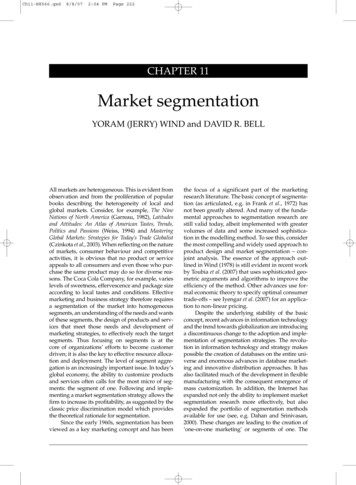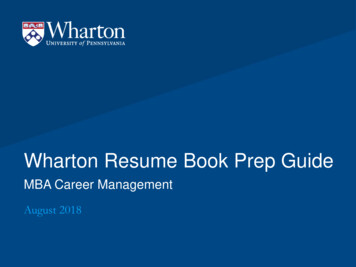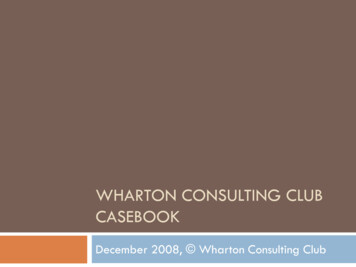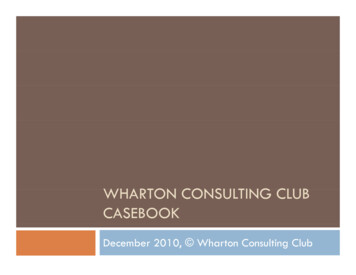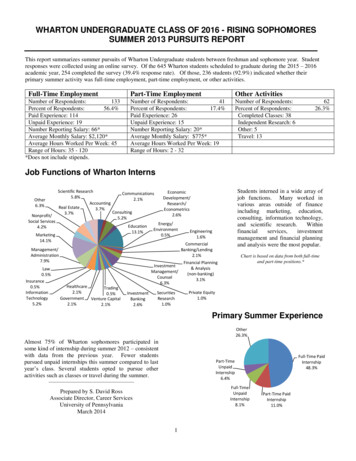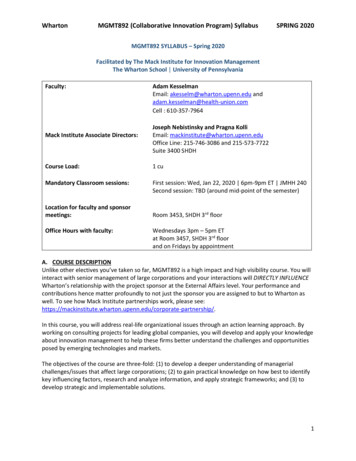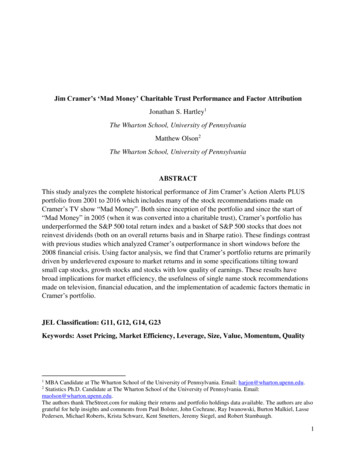
Transcription
Jim Cramer’s ‘Mad Money’ Charitable Trust Performance and Factor AttributionJonathan S. Hartley1The Wharton School, University of PennsylvaniaMatthew Olson2The Wharton School, University of PennsylvaniaABSTRACTThis study analyzes the complete historical performance of Jim Cramer’s Action Alerts PLUSportfolio from 2001 to 2016 which includes many of the stock recommendations made onCramer’s TV show “Mad Money”. Both since inception of the portfolio and since the start of“Mad Money” in 2005 (when it was converted into a charitable trust), Cramer’s portfolio hasunderperformed the S&P 500 total return index and a basket of S&P 500 stocks that does notreinvest dividends (both on an overall returns basis and in Sharpe ratio). These findings contrastwith previous studies which analyzed Cramer’s outperformance in short windows before the2008 financial crisis. Using factor analysis, we find that Cramer’s portfolio returns are primarilydriven by underlevered exposure to market returns and in some specifications tilting towardsmall cap stocks, growth stocks and stocks with low quality of earnings. These results havebroad implications for market efficiency, the usefulness of single name stock recommendationsmade on television, financial education, and the implementation of academic factors thematic inCramer’s portfolio.JEL Classification: G11, G12, G14, G23Keywords: Asset Pricing, Market Efficiency, Leverage, Size, Value, Momentum, Quality1MBA Candidate at The Wharton School of the University of Pennsylvania. Email: harjon@wharton.upenn.edu.Statistics Ph.D. Candidate at The Wharton School of the University of Pennsylvania. Email:maolson@wharton.upenn.edu.The authors thank TheStreet.com for making their returns and portfolio holdings data available. The authors are alsograteful for help insights and comments from Paul Bolster, John Cochrane, Ray Iwanowski, Burton Malkiel, LassePedersen, Michael Roberts, Krista Schwarz, Kent Smetters, Jeremy Siegel, and Robert Stambaugh.21
1. IntroductionThe usefulness of the financial advice from CNBC financial markets commentator JimCramer and other television finance personalities has historically been one of controversy.Cramer, unlike many other TV finance personalities, actually manages a stock portfoliothat invests in many of his stock recommendations made on his television show Mad Money.Initially established in August 2001 with approximately 3 million (according to Cramer’s GetRich Carefully), TheStreet.com’s Action Alerts PLUS (AAP) Portfolio has been the centerpieceof TheStreet.com’s financial advice, giving subscribers access to each trade the portfolio makesahead of time. In March 2005 at the launch of Cramer’s CNBC TV show Mad Money, the ActionAlerts PLUS Portfolio was converted into a charitable trust, and adopted the policy that anydividend or other cash distributions would be donated to charity. The portfolio has had relativestability in terms of its management over time, while Cramer lists himself as a “co-portfoliomanager” of the Action Alerts PLUS Portfolio. Recently in February 2015, Stephanie Link, theother Action Alerts PLUS Portfolio “co-portfolio manager” left TheStreet.com to join TIAACREF, being replaced by Jack Mohr.While previous papers have examined Cramer’s pre-financial crisis portfolio returns(Bolster and Trahan (2009)) or the market impact of his stock recommendations made on TV(Engelberg and Parsons (2011)), this is the first paper to fully examine the entire history of JimCramer’s Action Alerts PLUS portfolio returns before and after the financial crisis, adding sevenyears of post-financial crisis returns data from Cramer's Action Alerts PLUS portfolio. Further,this is the first paper to test for the potential presence of quality (QMJ) and betting against beta(BAB) factors in Cramer’s portfolio, in addition to the traditional leverage (MKT-Rf), size(SMB), value (HML) and momentum (UMD) factors. We take the same approach the same2
respect that Frazzini, Kabiller and Pedersen (2012), who analyze the risk factors underlyingWarren Buffett’s entre portfolio return history at Berkshire Hathaway.We find that Cramer’s AAP has underperformed the S&P 500 total return index and abasket of S&P 500 stocks that does not reinvest dividends both since inception of the portfolioand since the inception of Mad Money. In addition, Cramer’s portfolio has a lower Sharpe ratiothan both benchmarks over the same time period.We also find over the portfolio’s entire history that Cramer’s AAP portfolio exposuresare primarily driven by underlevered exposure to market returns (MKT-Rf) in everyspecification, which has heavily contributed to underperforming the S&P 500 in post-financialcrisis years. In other specifications, we find evidence of a tilt toward small cap stocks, growthstocks, and stocks with low quality of earnings. Also, when controlling for various factors invarious specifications, the negative alpha (intercept) from the regression no longer becomesstatistically significant.The paper proceeds as follows. Section 2 reviews the literature. Section 3 presents thedata and our empirical strategy. Section 4 reviews the results and Section 5 concludes.2. LiteratureSeveral papers examine the short-term market impact of Jim Cramer's stockrecommendations. Engelberg and Parsons (2011) and Engelberg et al. (2012) disentangle thecausal impact of media reporting from the impact of the events being reported. The authors thenfind that average abnormal overnight returns following his recommendations are over 3% fortheir entire sample and over 6% for stocks in the smallest quintile. The authors also find that theprice response is increasing in the number of wealthy viewers who watch the show but are3
unaffected by the number of low income households viewing the recommendations. The mainthrust of this study, however, is in determining whether or not certain stock recommendations aremore impactful than others, and whether or not the segment of the show in which therecommendation appears is priced. Results of this study can be used to make inferencesregarding the efficiency by which information promoted via a popular television show mayinfluence investor behavior (i.e. price discovery, market liquidity, market volatility & tradingvolume). Expanding on the findings of Neumann and Kenny (2007), Engelberg and Parsons(2011), and Engelberg et al. (2012), results from this study can be used to determine if mediaendorsements of individual stocks lead to mispricing, and whether or not the retail investor isbearing that cost. The implications of this research have the potential to reposition prior researchand to augment future thrusts in financial market research.Instead, this paper seeks to examine the long-term performance of Cramer's stockrecommendations, in particular the performance of Cramer's Action Alerts PLUS portfolio,commonly referred to as his charitable trust, which invests in the recommendations that hemakes on Mad Money.This paper builds on Bolster, Trahan and Venkateswaran (2012) and Bolster and Trahan(2009), adding seven years of post-financial crisis returns data from Cramer's Action AlertsPLUS portfolio.In addition, we test for the presence of other factors such as the Betting Against Beta(BAB) factor of Frazzini and Pedersen (2014) and the Quality Minus Junk (QMJ) quality factor ofAsness, Frazzini and Pedersen (2013).4
No studies to our knowledge analyze the performance of Jim Cramer’s charitable trust(Action Alerts PLUS portfolio) since its inception through the post-Great Recession crisisperiod.Bolster, Trahan and Venkateswaran (2012) analyzing Cramer’s “Mad Money” buy andsell recommendations between July 28, 2005 (the beginning of Cramer’s show Mad Money”)and December 31, 2008, find that the recommendations can impact the share prices of companiesthat he mentions. Their factor analysis suggests his returns are driven by beta exposure, smallerstocks, growth-oriented stocks and momentum effects.Their analysis is limited to 3.5 years from 2005 to 2008 and does not observe returnsduring a full recession period. In addition, they do not regress on any BAB or quality factors.3. Data and Empirical Strategy3.1 Action Alerts PLUS Portfolio (Mad Money ‘Charitable Trust’) Returns DataReturns data from the Action Alerts Portfolio PLUS are provided by TheStreet.comwhich are also made available to the public (See Table 1, Figure 1). Subscribers are also givenaccess to portfolio holdings data which we use to confirm some the findings of our risk factoranalysis.3.2 CRSP Mutual Fund Return DataWe also compare Cramer’s returns to the active equity mutual fund universe. To do so,we obtained the returns from the CRSP Mutual Fund database for all active equity mutual fundsthat were active during some period between August 2001 and December 2015 (see Figure 2).3.3 Factor Data and Analysis5
In our factor analysis of Cramer’s Action Alerts PLUS Portfolio excess returns (Rp,t –Rf,t), we run several specifications using popular academic factors. We also run the regressionsover 2 key time periods. First, we run regressions from the inception of the Action Alerts PLUSPortfolio in August 2001 to March 2016. We also we run regressions from the beginning of MadMoney in March 2005 (the same time the portfolio was converted into a charitable trust) toMarch 2016.This includes the CAPM (Equation 1) regressing Cramer’s excess returns on a leveragefactor (MKT–Rf) defined by the S&P 500 minus the risk-free 3-month T-bill rate:(Rp,t – Rf,t) α β* (Rm,t – Rf,t) εt(1)Our analysis also includes a Fama-French (1993) Three Factor Model (Equation 2) thatregresses Cramer’s excess returns on a leverage factor (MKT–Rf) in addition to size (SMB) andvalue (HML) factors obtained from the Ken French data library:(Rp,t – Rf,t) α βMKT* (Rm,t – Rf,t) βSMB * SMB t βHML*HML,t εt(2)We run another specification using the Carhart (1997) Four Factor Model (Equation 3)that includes a momentum factor (UMD), also obtained from the Ken French data library:(Rp,t – Rf,t) α βMKT* (Rm,t – Rf,t) βSMB * SMB t βHML*HML,t βHML*UMD,t εt(3)In separate specifications, we also regress Cramer’s excess returns on the Frazzini andPedersen (2014) Betting-Against-Beta factor and the Asness, Frazzini and Pedersen (2013)Quality Minus Junk (QMJ) factor.4. Results4.1 Factor AttributionThe results of the regressions are reported in Table 2. Analyzing the entire history of theportfolio, our CAPM specification finds a CAPM Beta of approximately 0.95 (statistically6
significant at the 1% level) and a negative alpha of -2.38% that is statistically significant (at the10% level). Being underleveraged (underinvesting in the market portfolio) in part may be a resultof the portfolio’s policy of not reinvesting cash dividends.Across almost all of our specifications, the results demonstrate that underleverageexplains most of the portfolios relative underperformance given the S&P 500’s positive absoluteperformance over the period. This is also confirmed by the portfolio holdings data whichindicates that the AAP portfolio often holds a significant cash position, largely to make its annualcash distribution in March to make charitable contributions.In our Fama-French (1993) three factor specification, we do find that the portfolio hassome exposure to small caps given that the SMB factor is statistically significant at the 10%level, something confirmed by the portfolio holdings data. We do not find such a statisticalsignificance when only looking at the entire history of Mad Money from 2005.Also, when controlling for momentum factors in our Carhart (1997) four factor specification,statistical significance of the size factor also disappears nor do we find evidence of statisticallysignificant exposure to momentum stocks.However, we do find that when analyzing the March 2005 to March 2016 time period,when adding the extra size, value and momentum factors in the Fama-French (1993) and Carhart(1997) 4 Factor regressions that the statistical significance of the negative alpha of -3.06%, foundin the CAPM for the same period, disappears.When we include the Frazzini and Pedersen (2014) Betting-Against-Beta factor and theAsness, Frazzini and Pedersen (2013) Quality Minus Junk (QMJ) factor, we find some evidencethat Cramer tilts toward growth stocks and away from stocks with high quality of earnings.7
4.2 Factor ReplicationUsing the factor analysis results obtained above, we also construct a “robo-Cramer”portfolio that uses the same factor loadings as estimated from the regressions (Figure 3). Thesystematic Cramer-style portfolio is constructed from the same regressions of monthly excessreturns in 3.2, namely the Carhart Four Factor regression using data over the entire time period(August 2001 to March 2016). The portfolio is rebalanced annually at year-end to keep constantweights. The explanatory variables are the monthly returns of the standard size, value, andmomentum factors. Note that such a synthetic portfolio outperforms Cramer’s actual cumulativereturns for the entire period.4.3 Financial Education and Portfolio Diversification Among ‘Mad Money’ ViewersThere is an important question of how many viewers have used Cramer’s financial advicein their own portfolio decisions.Ratings from Nielsen (Figure 4) indicate the number of Mad Money viewers has waned inrecent years.Analyzing TheStreet.com’s public financial disclosures also provides some insight intothe number of subscribers potentially taking Jim Cramer’s stock advice provided through thisAction Alerts PLUS Portfolio, which sends daily stock pick updates to viewers. TheStreet.com(TST) held its IPO at the height of the tech bubble in 1999 and while remaining a publiccompany, stock price has fallen as well (Figure 6a). However, revenue for subscriptions toTheStreet.com’s subscriptions has steadily risen (Figure 6b), indicating that consumers may notbe responding to waning performance relative
Several papers examine the short-term market impact of Jim Cramer's stock recommendations. Engelberg and Parsons (2011) and Engelberg et al. (2012) disentangle the causal impact of media reporting from the impact of the events being reported. The authors then find that average abnormal overnight returns following his recommendations are over 3% for their entire sample and over 6% for



